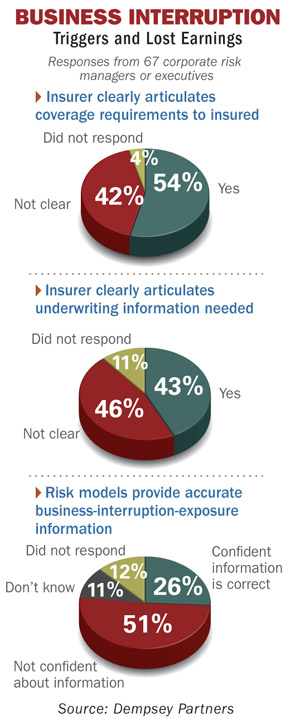NU Online News Service, March 20, 2:34 p.m.EDT
|Risk managers are not confident that the loss-of-earningstrigger for business-interruption coverage is clearly explained tothem, and many feel that the products that are available do notadequately cover their risks.
|Those were some of the findings of a risk-manager survey done bythe forensic-accounting, claims-management and risk-consulting firmDempsey Partners in February.
|
The survey asks risk managers to evaluate their supply-chainexposure-insurance solutions in the wake of flooding inThailandandthe earthquake and tsunami inJapan.
|More than half, 52 percent, of the respondents that experienceda loss in the past five years say they have never recovered asupply chain or related loss claim. Sixty-one percent of thosesurveyed say they experienced a supply-chain disruption withinthe past five years.
|When it comes to insurance policies and triggers for coverageafter a loss, 54 percent of the respondents say their propertyinsurer clearly articulated and explained the business interruptionvalue reporting requirement, while 42 percent say their insurer wasnot clear about it. The balance declined to answer.
|Regarding the type of information that the insurers need tounderwrite supply-chain risks, 43 percent of risk managers saytheir insurer explained it to them, while 46 percent feel theirinsurer failed to explain what was needed.
|As far as confidence that insurers' models provide accuratebusiness-interruption data, only 26 percent say they were confidentthe data was sufficient, while 51 percent say they lackedconfidence. Eleven percent say they did not know, while theremainder says it was not applicable.
|The survey received 67 responses from risk managers or otherfinancial executives with the responsibility for therisk-management function. Of the 67 responses, 54 were from thosewith the specific title of risk manager, primarily with largecorporations.
|Explaining the results, John Dempsey, managing partner ofDempsey Partners, tells NU Online News Service that a major part ofthe problem for underwriters explaining the underwriting criterionis that the tools they are using are antiquated while the riskshave become increasingly complex.
|“The standard business-interruption worksheet was developed over100 years ago when businesses were much simpler than they aretoday,” says Dempsey.
|He notes that a multi-national corporation with a diverseportfolio of businesses can no longer be adequately underwrittenwith tools that were designed to write a single-risk exposure.
|Underwriters today need tools that can aggregate moreinformation and take into consideration the loss-mitigationtechniques a company is incorporating into its structure, such asdouble sourcing to avoid a shutdown of operations, saysDempsey.
|He says risk managers have begun to “take matters into their ownhands” and perform their own risk surveys of their operations topresent to underwriters in order to explain their business and“differentiate themselves from their peers,” a practice that helpsboth the buyer and seller of insurance.
|As far as what insurers are offering in terms of coverage,Dempsey says when the insured suffers a business-interruptionevent, but fails to obtain insurance recovery, it is often becausethe trigger event was not covered, such as when flights to and fromEurope were cancelled due to volcanic ash spewing over Iceland inearly 2011.
|He says such coverage-gap events “are an opportunity forinsurers to expand their business offerings and collect morepremiums along the way.”
Want to continue reading?
Become a Free PropertyCasualty360 Digital Reader
Your access to unlimited PropertyCasualty360 content isn’t changing.
Once you are an ALM digital member, you’ll receive:
- All PropertyCasualty360.com news coverage, best practices, and in-depth analysis.
- Educational webcasts, resources from industry leaders, and informative newsletters.
- Other award-winning websites including BenefitsPRO.com and ThinkAdvisor.com.
Already have an account? Sign In
© 2024 ALM Global, LLC, All Rights Reserved. Request academic re-use from www.copyright.com. All other uses, submit a request to [email protected]. For more information visit Asset & Logo Licensing.








